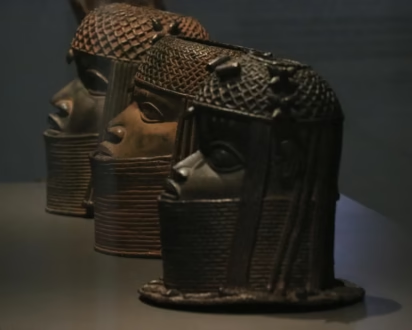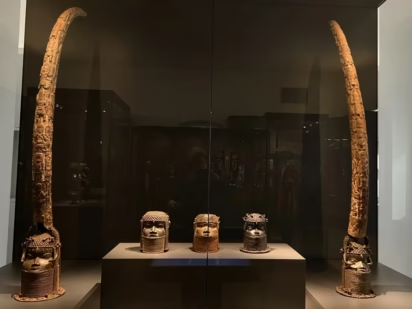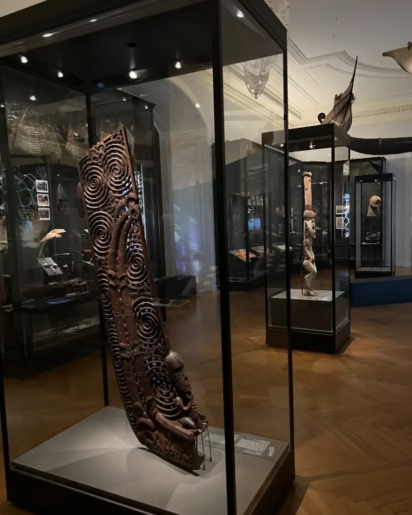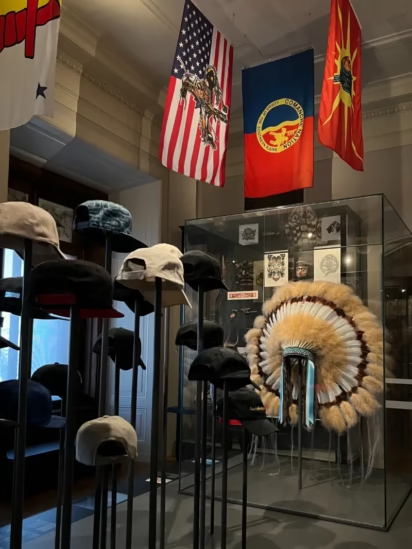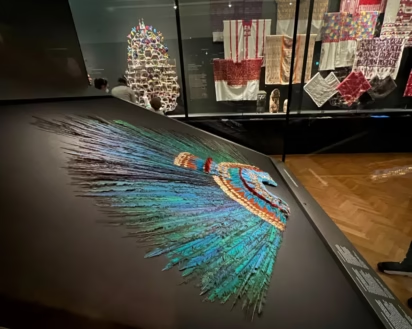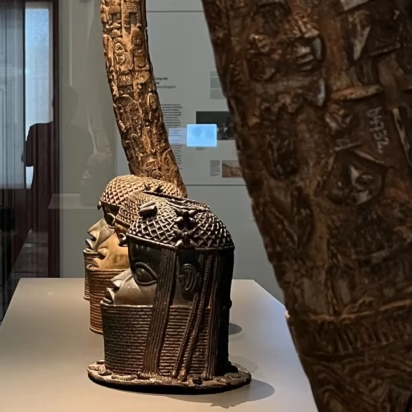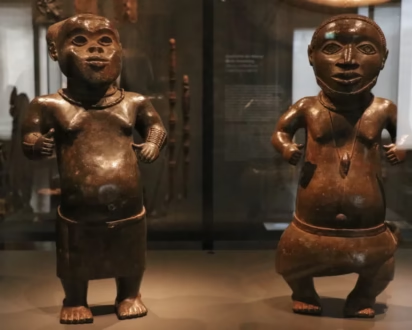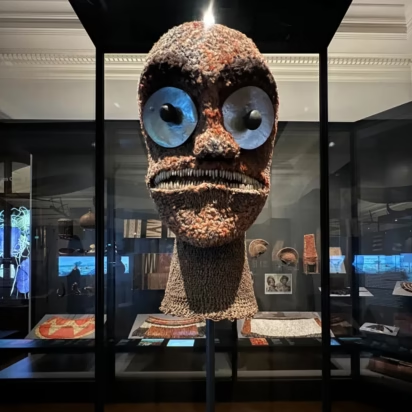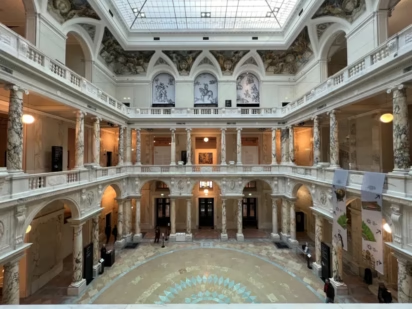Highlights in the Weltmuseum Wien (World Museum of Ethnology in Vienna) include a Mexican feather headdress, Benin bronzes, and part of the James Cook collection of Polynesian art.

A visit to the Weltmuseum Wien (World Museum of Ethnology) is a wonderful diversification from the European art and Central European history that Vienna offers in abundance. The highlights of one of the world’s great ethnological collections include the only pre-Columbian feather headdress that survived from Mexico and a large collection of Benin Bronzes. Weltmuseum Tickets include admission in the same building to the large Imperial Armory and the Collection of Old Musical Instruments.
Weltmuseum Wien (World Museum of Ethnology in Vienna)
The Weltmuseum Wien in Vienna is one of the world’s great ethnographical collections. Formerly the Museum für Völkerkunde (Ethnographic Museum), the new Weltmuseum name was introduced in 2013 to reflect the interaction of items from all over the world with Austria. No longer is art from other cultures presented as exotic (or even in some instances as primitive). Inputs from countries of origin and local diasporas are welcomed — not only in the presentation but also at events and lectures organized by the museum.
As with other major ethnographic collections in Europe, such as the Humboldt Forum in Berlin and the Grassi in Leipzig, the provenance of many items is questioned and more intensively researched. Although Austria played a minor role in colonization outside Europe, it cannot be ignored that many items here were originally obtained through irregular means.
Permanent Exhibitions in the Weltmuseum Wien
The Weltmuseum Wien describes its permanent exhibition as being strung together like a chain of pearls. However, it has been observed that the 14 galleries are freestanding and without a real unifying reason, other than a link to Vienna or Austria. (Sometimes as basic as being purchased by an Austrian trader in foreign climes.) While some individual items are explained in detail, it is often hard to appreciate the larger context, especially if there are no further related objects to widen the experience.
However, if many items are appreciated individually for their own merit the museum is easy to enjoy. The permanent exhibitions include items of astonishingly high artistic quality, as only a small fraction of the museum’s over 500,000 items are displayed. Most descriptions are in both German and English making it easy enough to appreciate each item on its own.
For most visitors, the following are likely to be the more interesting halls (and are described in more detail below):
- Stories from Mesoamerica — including the Mexican feathered headdress.
- Benin and Ethiopia: Art, Power, Resilience — including a large collection of Benin bronzes and imperial gifts of Ethiopian Emperor Menelik II.
- South Seas: Encounters with Paradise Lost — an interesting collection of large and small objects collected during at least four expeditions to the Pacific Islands, including items from the James Cook Collection.
- 1873 — Japan Comes to Europe: Japan presented itself as a modern state at the World Fair in Vienna in 1873.
- Collecting Craze. I Suffer from Museomania — Three Habsburg princes collected with abundance in the 19th century.
Further exhibitions include:
- Into a New World — items from North America, including a large (modern) feather headdress and contemporary baseball caps.
- A New Perception – View on China: Europe’s fascination with the high culture of China changed during the 1800s when China was viewed as a new market and several wars were fought between European powers and China.
- An Austrian Mosaic of Brazil — items collected in Brazil, especially after Leopoldina of Austria (later first Empress of Brazil) went to South America.
- Fascinated by Indonesia – including wood carvings and batik materials.
- At the Threshold of the Orient — items from the near Orient, i.e. regions to the southeast of Vienna, which at times were part of the Ottoman Empire.
- A Village in the Mountains — items from a Himalayan Buddhist village.
- World in Motion — why people and things move internationally.
- In the Shadow of Colonialism — an explanation of how works were acquired and how museums deal with items collected during the colonial period.
- Culture War in Vienna — late 19th and early 20th-century culture war led by conservatives against an increasingly godless world.
See the Mexican Feathered Headdress in the Weltmuseum Wien
The most famous item in the Weltmuseum Wien is the Mexican feathered headdress. Also known as and in Spanish as the Penacho de Moctezuma, this is the only prehispanic feathered headdress that survived anywhere in the world. It almost certainly was not the headdress of one of the last Aztec rulers, Moctezuma II, but debate continued over its provenance and original purpose. It was first mentioned to be in Austria in 1596 and is assumed to have left Mexico already around 1520 with the first treasures being transported to Europe.
The museum has further interesting items from pre-Columbian Mexico and Central America but also more contemporary explanations of Mexican customs, including the love for skeletons as decorations for Day of the Dead celebrations. A taxidermy mount shows a Quetzal — the small bird that provided the most coveted feathers in the Aztec empire.
→ More details at: See the Aztec Feathered Headdress in the Weltmuseum Wien in Vienna
Benin Bronzes and Gifts from Ethiopia in the Weltmuseum Wien

The Benin und Äthiopien: Kunst, Macht, Widerstand hall explains the contrasting fates of two 19th-century African kingdoms:
In the late 19th century, Oba Ovonramwen, King of Benin (in present-day Nigeria), opposed the British and lost his kingdom (and treasure), while Emperor Menelik of Ethiopia managed to expand his territory and engaged successfully with European diplomacy.
The Weltmuseum Wien has with just over 200 items, the seventh-largest collection of Benin bronzes in the world. These were looted from Benin in 1897 with the items in Vienna purchased from the British Museum in London, which had to sell some works to finance the expedition retrospectively.
In addition to several commemorative heads produced using the lost-wax technique, the collection also includes relief plaques and ivory tusks with relief carvings.
Two highly praised works are the two Court Dwarfs (akaeronmwon), produced from brass in Benin in the 14th or 15th century. These are among the earliest art from Benin and probably depict two historic individuals. Court dwarfs were used at least since the 15th century in the Benin court as the voice of the king and to break “delicate” news.
These items are well described in the online catalog of the museum as well as at Digital Benin.
The splendor of the Ethiopian empire is displayed through an imperial dress ensemble and other honorary symbols sent by Emperor Menenlik II as gifts to Austrian Emperor Franz Joseph in 1914. Further diplomatic gifts included a saddle, shields, and weaponry. (He also sent three lions, two zebras, and a giraffe for the royal menagerie.)
South Seas: Encounters with Paradise Lost
The Südsee Gallery has an interesting collection of large and small objects collected during at least four expeditions to various Pacific Islands — including the first circumnavigation of the globe by an Austrian boat (1857-59).
One of the most impressive displays is a large feather bust of a god with huge mother-of-pearl eyes and nearly 100 dogs’ teeth (1779) collected by Captain James Cook in Hawaii. This kii hulu manu was carried on a wooden pole to scare the enemy during battle.
Further items include objects from everyday and ritual worlds, ornamental shields, wood-carved figurines, hunting equipment, boats, and clothing. Particularly impressive are some architectural elements and decorations used on war canoes.
Japan in the Weltmuseum in Vienna

The museum’s large collection of Japanese items is largely due to the fascination among the European elite with Japan after the country was finally forced to open to the outside world. Japan decided to project itself as a modern state at the World Fair in Vienna in 1873. Around 6,000 items were selected for display at the fair, including the large model of a Daimyo residence that is now in the Weltmuseum.
Further items from Japan include Samurai dress, weapons, and masks. Many further items show the interaction between Japan and Europe in the Meiji Period (1868-1912). Japanese wood prints influenced European art while Art Nouveau designs were copied into Japanese products.
Museomania

Many of the items in the Weltmuseum Wien were originally part of the various royal collections of the Habsburgers who ruled Austria for centuries. The Collecting Craze. I Suffer from Museomania (Sammlerwahn. Ich leide an Museomanie!) is a good example of how some of the ruling elite bought up collections en masse while traveling internationally.
This hall shows the collection of three 19th-century Habsburg princes who collected enthusiastically during their travels (and all three died violently in unrelated events):
- Prince Ferdinand Max traveled the Mediterranean, visited Brazil, and encouraged Austria’s first voyage of circumnavigation before being executed in 1867 as the Emperor of Mexico. (The Mesoamerica collection in the Weltmuseum is largely unrelated to this sorry event.)
- Crown Prince Rudolf traveled the Nile and collected extensively from Africa before falling in love with the wrong woman and committing suicide in 1889.
- Archduke Franz Ferdinand traveled widely, including circumnavigating the world (1892-3), and collected enthusiastically. He planned the largest museum in Vienna for his collection but was of course assassinated in 1914, a major casus belli for the First World War.
The often unlabeled items in this display are well explained by Franz Ferdinand’s own words: “I suffer from museomania!” These princes had the opportunity to buy whatever they saw and fancied. They had the money, especially Franz Ferdinand who was one of the richest persons in Austria even before becoming first in line for the throne.
Weltmuseum Wien Visitors’ Information

Weltmuseum Opening Hours
The Weltmuseum is open daily except Wednesday from 10:00 to 18:00, closing at 21:00 on Tuesdays. The museum is closed on Wednesdays.
As with any decent museum in Vienna, a pleasant café-bistro is available for coffee and cake or a light lunch. The Cook Café & Bistro is in the pillared courtyard in the center of the museum and accessible without having to pay admission.
Tickets for the Weltmuseum Wien in Vienna
The Ticket Neue Hofburg gives admission to all three museums in this wing of the Hofburg: the Weltmuseum Wien (Ethnology), the Hofjagd- und Rüstkammer (Hunting and Armory), and the Sammlung Alter Musikinstrumente (Collection of Old Musical Instruments). Separate tickets for the three museums are not sold.
The Neue Hofburg Ticket is €16, €12 for students up to 25 and pensioners 65+, and free for children under 18 years old. The Vienna City Card and various sightseeing passes give some discounts.
Tickets are valid for the calendar day and time-slot reservations are usually not available (or needed), except for occasional major temporary exhibitions.
Transportation to the Weltmuseum Wien in Vienna
The Weltmuseum Wien (World Museum Vienna), the Hofjagd- und Rüstkammer (Hunting and Armory), and the Sammlung Alter Musikinstrumente (Collection of Old Musical Instruments) are in the Neue Hofburg wing of the imperial palace with the entrance from Heldenplatz. However, for transportation purposes, it is easier to remember it is across the Ring road from the Kunst Historisches Museum. The closest tram stop is Burgring.
→ See also: See the Aztec Feathered Headdress in the Weltmuseum Wien in Vienna for more on this important Mexican cultural object.
